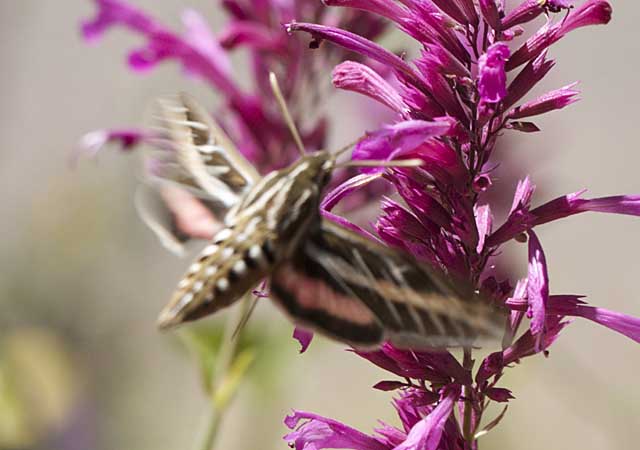Sphinginae subfamily
Sphingini tribe:
 |
Agrius cingulata,
USGS, stray, Pink-spotted Hawkmoth:
Strong migrant, adults nectar from deep-throated flowers including moonflower (Calonyction aculeatum),
morning glory (Convolvulus), honey suckle (Lonicera) and petunia (Petunia species).
|
 |
Ceratomia amyntor WO,
Elm Sphinx, Four-horned Sphinx: Brown with dark brown and white markings including white costal area near wing base, dark streaks along veins,
white spot in cell. edge of range
|
 |
Ceratomia undulosa WO, Waved Sphinx:
Pale brownish gray (sometimes dark) with wavy black and white lines and black-outlined white cell spot.
Named for wavy lines on forewings.
|
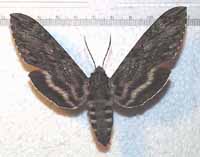 |
Lintneria separatus USGS, Separated Sphinx:
Dark gray with black and light gray wavy lines. The upperside of the hindwing is black with a brownish
gray border and two white bands.
|
 |
Manduca quinquemaculatus WO, Five-spotted Hawkmoth:
Tobacco fields and vegetable gardens (potatoes, tomatoes)
and wherever host plants are found. edge of range
|
 |
Manduca sexta
WO, Carolina Sphinx:
If you grow tomatoes, you may have encountered it.
Larvae get very large and can strip tomato plant. edge of range
|
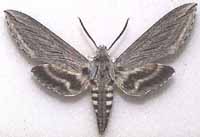 |
Sphinx asellus USGS, Asella sphinx:
Pale silver-gray with a series of black dashes, white patch at tip, white stripe along
outer margin. Hindwing black with blurry white bands. edge of range
|
 |
Sphinx chersis WO, Northern Ash Sphinx, Great Ash Sphinx:
Larval hosts are ash, lilac, privet, cherry, and quaking aspen.
|
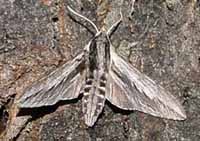 |
Sphinx dollii WO, Doll's sphinx:
Wing span: 1 3/4 - 2 1/2 inches (4.5 - 6.3 cm):
flies in arid brushlands, desert foothills from Nevada and
southern California east through Utah,
Arizona, Colorado, New Mexico to Oklahoma, Texas.
|
 |
Sphinx drupiferarum USGS, Wild Cherry Sphinx:
Forewings: long, slender, held close to body when resting. Costal and terminal areas of fw much
lighter than slate grey colouration of rest of wing.
|
 |
Sphinx gordius USGS, Apple Sphinx:
Ranges from brown with black borders through brownish gray with paler borders to pale gray with no borders.
Dashes, submarginal line, and cell spot are usually weak. edge of range
|
 |
Sphinx luscitiosa WO, Canadian Sphinx,
Clemen's Sphinx: Fw: yellowish gray in males and pale gray with faint yellow tint in females (female to left). Dark
border on outer margin widens as it approaches inner margin. Hw upperside is deep yellow in males,
pale yellow in females, both with wide dark border.
|
 |
Sphinx vashti USGS, Snowberry Sphinx:
Adults fly as single brood in montane woodlands, along prairie
streamcourses from April to August.Fw upperside has narrow black subterminal line
bordered by white inverted V-shaped line on outside, and black line at apex.
|
Smerinthini Tribe:
 |
Pachysphinx modesta USGS, Modest Sphinx, Poplar Sphinx:
This moth has a large, heavy body, and females can be remarkably plump. Lines are blurred, less distinct than in P. occidentalis.
|
 |
Pachysphinx occidentalis USGS, Big Poplar Sphinx:
Quite similar to Pachysphinx modesta, with modesta being smaller and darker.
Moths should be on the wing from June-August.
|
 |
Paonias excaecata USGS, Blinded Sphinx:
Fw outer margin quite wavy. Dark cell spot, dark oblique line mid wing from
costa almost to inner margin. Basic ground colour is
pinkish brown. Flight would be June-July.
|
 |
Paonias myops USGS, Small-eyed Sphinx:
Named for the small eye-spot in the hindwing, this moth has a wide distribution.
|
 |
Smerinthus cerisyi
WO, the Cerisyi's
Sphinx or One-eyed Sphinx, Larvae feed on poplars and willows.
Flight would be from late May-July-early August as a single brood. edge of range
|
 |
This moth is widely distributed and fairly common.
Along the East Coast, it flies from P.E.I. to Florida.
It is less common in the southwest.
|
Macroglossinae subfamily
Dilophonotini tribe:
 |
This species is reported in Boulder County,
but would likely only be there as a migrant stray
from further south.
Males and females differ.
|
 |
Hemaris diffinis
USGS, the
Snowberry Clearwing or Bumblebee Moth
Hemaris diffinis is a very variable species, but almost always the
abdomen sports contrasting black and yellow hairs, the ventral
surface being quite black. The legs also tend to be quite dark and
there is a black mask running across the eye and along the sides of
the thorax.
|
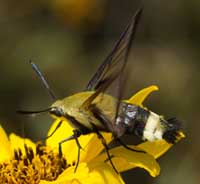 |
Hemaris thetis USGS, the Thetis Clearwing or Bee Hawk Moth,
The moth flies along forest edges and in meadows, gardens and
brushy fields. Day-flying adults nectar at lantana, dwarf bush honeysuckle,
snowberry, orange hawkweed, thistles, lilac, Canada violet, etc.; generally more westerly
|
Philampelini tribe:
 |
Adults nectar from flowers of Japanese honeysuckle
(Lonicera japonica), petunia (Petunia hybrida),
mock orange (Philadelphus coronarius), and phlox (Phlox).
Fight would be from June to August. Larvae feed on grape foliage.
|
Macroglossini tribe:
 |
This day flier is widely distributed. If you have Virginia Creeper,
you probably have the Nessus Sphinx.
Two bright, distinct, narrow yellow
bands are often visible on the abdomen. edge of range
|
 |
Darapsa myron
WO, the Virginia Creeper Sphinx or the
Grapevine Sphinx
The forewing upperside is dark brown to pale yellowish gray, with an
olive tint, sometimes quite green.
On the costal margin there is a dark rectangular patch, although this
may be reduced or absent. The upperside of the hindwing is pale
orange.
|
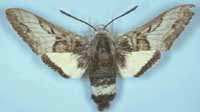 |
Euproserpinus wiesti
WO, Prairie Sphinx or Wiest's Primrose Sphinx:
Black body with white band on abdomen. FW upperside
gray-brown; median area has black lines and gray band;
underside white with black o. m..
Hw upperside yellowish white with narrow black
o. m., black at base.
|
 |
Hyles lineata
NH/USGS,
the White-lined Sphinx
The forewing upperside is dark olive brown with paler brown along the
costa and outer margin, a narrow tan band running from the wing tip
to the base, and white streaks along the veins.
The hindwing upperside is black with a reddish pink median band.
|
Hyles lineata, Colorado Springs, September 19, 2010, Norman Hayward.
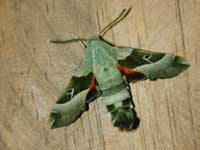 |
The upperside of the forewing is pale gray-green with a deep
green-brown median area and a white dash at the wing tip.
|
|
|
